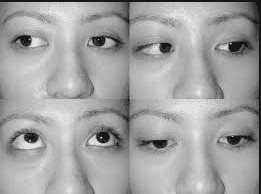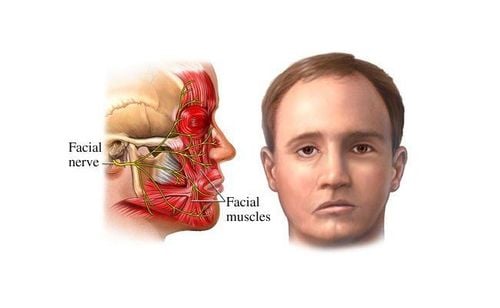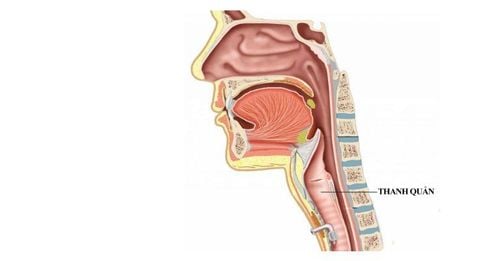This is an automatically translated article.
The article was professionally consulted by Specialist Doctor I Tran Thi Ngat - Department of General Surgery - Vinmec Da Nang International General Hospital. Dr. Ngat has more than 15 years of experience as an Anesthesiologist.Tonsillitis and laryngeal cancer are becoming more and more common among nasopharyngeal cancers. Treatment for tonsil/laryngeal cancer includes surgery, radiation therapy, and chemotherapy, possibly using one or more of these treatments at the same time. In the treatment of tonsil cancer, laryngeal cancer removal, anesthesia plays a very important role.
1. Cancer of tonsils, cancer of larynx
Tonsillitis cancer originates in the cells in the tonsils. The tonsils are oval-shaped organs at the back of the mouth that are part of the immune system that protects the body from pathogens.Cancer of the tonsils is a dangerous disease with a high risk of death. However, if detected early and treated promptly, we can still control this disease. Some common symptoms of tonsil cancer are: persistent sore throat, ear pain, difficulty swallowing, pain when swallowing, pain when eating sour fruits, neck pain, spitting with blood, possibly Difficulty breathing,... The above symptoms are easy to confuse with other diseases such as pharyngitis, tonsillitis, so it is easy to be ignored and when it develops it is often late.
Laryngeal cancer is cancer that originates from the larynx epithelium, which occurs when the epithelium grows out of control and forms a tumor.
The larynx is an organ located in the front of the neck, about 5cm long, about 5cm wide, located above the trachea. The larynx plays an important role in our daily breathing, swallowing and speaking.
Laryngeal cancer can invade surrounding structures and metastasize by lymphatic and hematopoietic routes. The most common metastasis of laryngeal cancer is the lung metastasis.
Laryngeal cancer, like many other cancers, often has no obvious signs, so it is easy for patients to miss, when detected, it is often at a late stage. Some common symptoms of laryngeal cancer include hoarseness, cough, difficulty breathing, difficulty swallowing, weight loss.
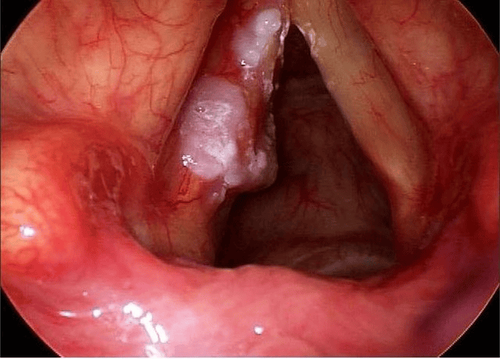
2. Laryngeal mask anesthesia to cut tonsils/larynx cancer
Surgery to remove tonsil cancer, laryngectomy is one of the main treatment methods of these two diseases. A successful surgery depends on many factors, including anesthesia. Currently, there are many different anesthetic methods, one of which is laryngeal mask anesthesia.Laryngeal mask anesthesia is a technique of general anesthesia with a laryngeal mask placed for the purpose of breathing control during surgery. This method of anesthesia is contraindicated in the following cases:
Stomach full. Patients with maxillofacial lesions complicated by trauma or infection. The surgical facility does not have enough anesthesia and resuscitation facilities. The basic steps in laryngopharyngeal mask anesthesia for endoscopic surgery to remove nasopharyngeal tumors include:
Checking records, examining patients Position of patient in supine position, breathing 100% oxygen at a rate of 3 - 6l /min, or breathe CPAP at least 5 minutes before induction of anesthesia until the oxygen concentration in the exhaled air reaches at least 90%. Install the monitor, set up the transmission line. Pre-anesthesia if necessary. Induction of anesthesia: Sleeping pills: intravenous anesthetics, volatile anesthetics. Painkillers Muscle relaxants The condition for placing a laryngeal mask is that the patient sleeps deeply and has enough muscle relaxation. The technique of placing a laryngeal mask is as follows: The patient's head is in an intermediate or slightly supine position. With one hand open the patient's mouth, the other hand put the laryngeal mask through the dental arches, to the base of the tongue, put the back of the mask on the hard palate, push the mask to slide along the hard palate to enter the hypopharynx. When you feel resistance, stop and pump the cuff. Check the tightness and position of the laryngeal mask. Permanent. Maintain anesthesia. Control breathing, monitor patient's vital signs.
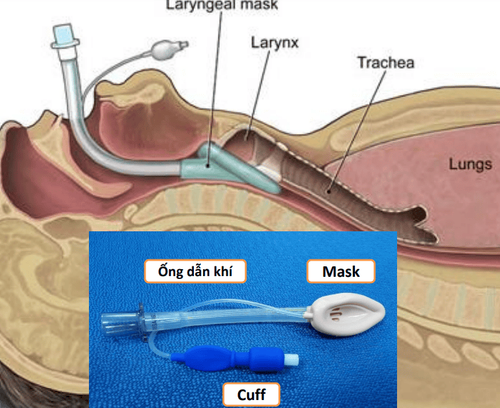
Reflux of gastric juice into the airway. In this case, it is necessary to aspirate the fluid immediately, place the patient in a low lying position, and tilt the head to one side. Need to monitor, prevent lung infection later. Hemodynamic disorders: hypotension or hypertension, cardiac arrhythmias (tachycardia, bradycardia, arrhythmia). Treatment depends on symptoms and causes. Accidents caused by laryngeal mask placement: laryngeal mask could not be placed. Vocal-tracheal-bronchospasm Injuries when putting on a laryngeal mask: bleeding, tooth fracture, vocal cord injury, foreign object falling into the airway,. .. Respiratory complications: folding, slipping of the laryngeal mask, opening of the respiratory system, lack of oxygen, lack of oxygen, .... In this case, it is necessary to ensure immediate ventilation and provide 100% oxygen to the patient. patient, then find the cause and solve. Complications after removing the laryngeal mask such as respiratory failure, sore throat, hoarseness, laryngospasm - gas - bronchi, upper respiratory tract inflammation,... Depending on the complications, the doctor will have treatment methods. appropriate to remedy such complications.
Vinmec International General Hospital is one of the hospitals that strictly applies safe surgical anesthesia practice standards according to international guidelines. Vinmec has a team of experienced anesthesiologists and nurses, modern equipment such as: nerve detectors, ultrasound machines, Karl Storz difficult airway control system, comprehensive anesthesia monitoring system GE's AoA (Adequate of Anesthesia) including monitoring of anesthesia, pain and muscle relaxation will provide high quality and safety, helping patients to have adequate anesthesia, not awake, no residual muscle relaxant after surgery.
Vinmec Health System is also proud to be the first hospital in Vietnam to sign with the World Anesthesiology Association (WFSA) towards the goal of becoming the safest hospital for surgical anesthesia in Southeast Asia.
Please dial HOTLINE for more information or register for an appointment HERE. Download MyVinmec app to make appointments faster and to manage your bookings easily.





